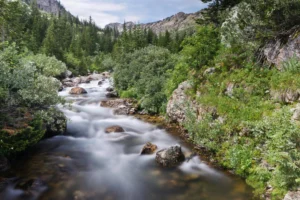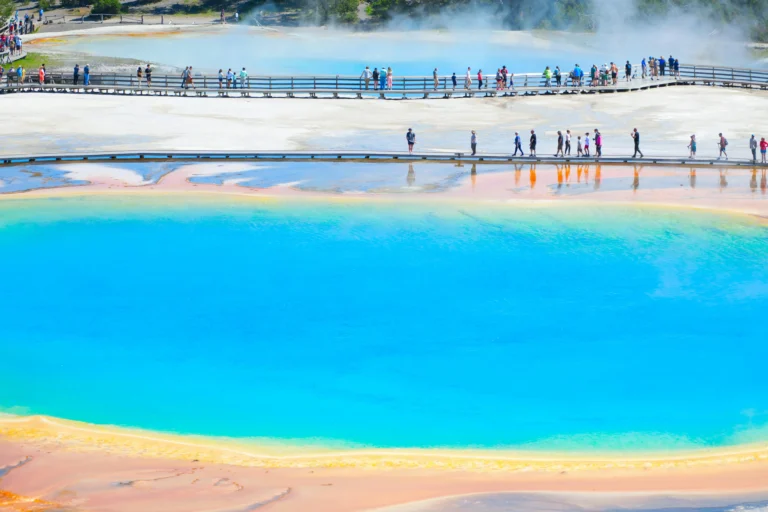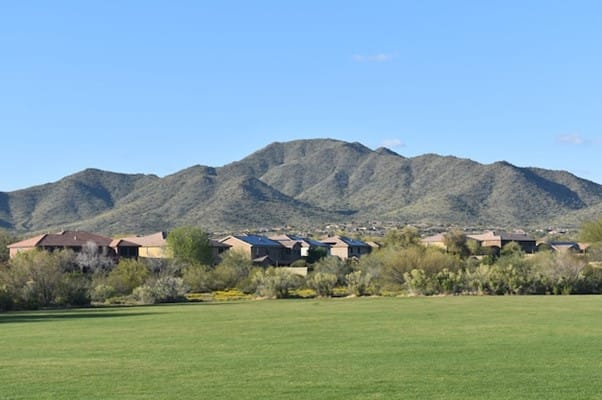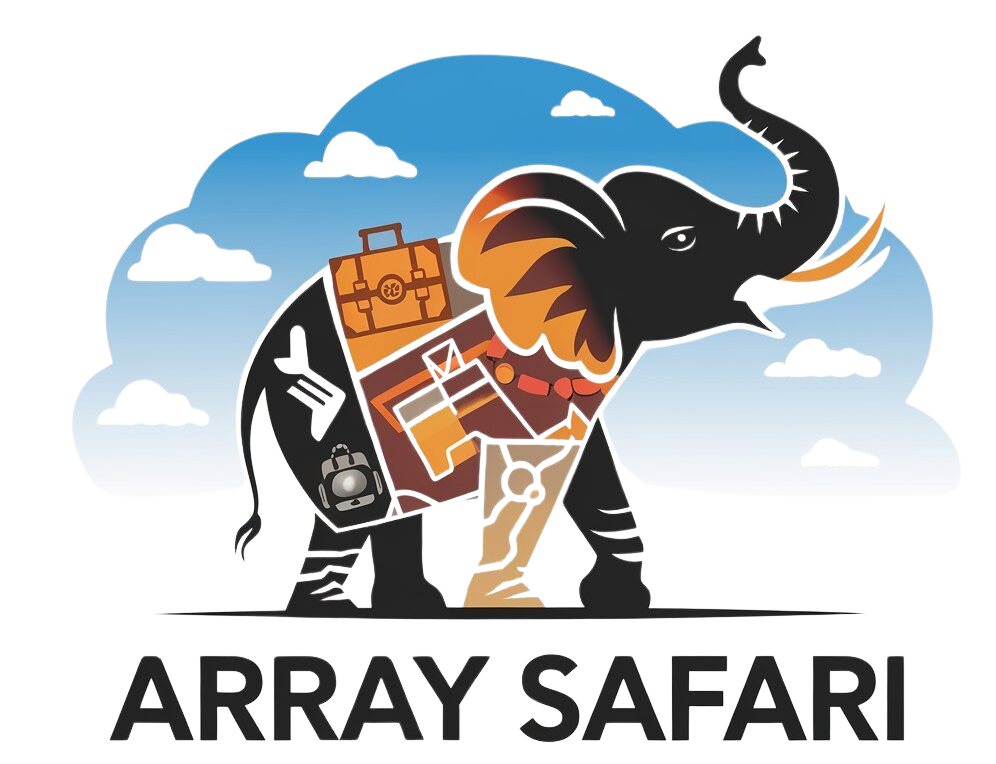The Grand Teton is a big alpine climb. Above the park, the on average 13,776 feet Grand Teton is the highest summit in Grand Teton National Park and the third highest in the state of Wyoming. Though unlike most large mountains, it does not have low visible foothills, the range is high enough that no foothills are lower than 7,000 feet. That’s about 7,500 ft of gain in one go. The climb includes glacier trekking, scrambling and technical rock climbing (up to 5th-class moves on some routes). The peak was first ascended by William Owen and Franklin Spalding in 1898; they used the traditional Owen–Spalding climbing route (rated “5.4”). Snow persists in shadowy gullies until mid-July, and summer storms bring lightning and rockfall. Climbers should be fit, self-reliant and prepared for steep snow, ice and rock. By park rule, however, threats like lightning, rockfall, avalanches, crevasses and extreme weather are par for the course.
Grand Teton climbs begin with careful preparation. Most climbers train months in advance – building endurance with hiking and cardio and practicing multi-pitch rope skills. Guided programs (e.g. Exum Mountain Guides or Jackson Hole Mountain Guides) typically include 1–2 days of instruction in ropework, belaying, rappelling and anchor building. Acclimatization is critical: climbers often spend time above 8,000 ft or use back-to-back alpine climbs to adapt. Climbers pack layers, mountaineering boots, an ice axe and crampons (for snow/ice) and rock-climbing gear (harness, helmet, slings, cams/nuts). A 60–70 m rope is needed for the summit rappel. Guides supply much technical gear, but climbers must bring warm clothing, headlamps, food, water and emergency shelter. In short, train hard, learn rescue skills, and carry all essentials before attempting to summit Grand Teton.

How to summit Grand Teton’s peaks?
Climbers reach Grand Teton’s summit by planning carefully, selecting a route, and executing a multi-day climb. The typical ascent follows these steps:
- Approach and camping. Most parties hike up Garnet Canyon to Corbett High Camp (~11,200 ft) over 2–3 days. For example, Jackson Hole Mountain Guides notes a 7-mile approach with ~4,200 ft gain taking about 5–7 hours. Parties may bivouac at the Lower Saddle or use the stone hut there. Camp is at treeline under the Grand.
- Technical skills training. Climbers often spend 1–2 days doing classes at trailhead or camp. Skills include tying knots, belaying, multi-pitch movement and rappelling. Guides equip clients with harnesses and helmets and climb practice routes nearby.
- Summit day. An alpine start (~3:00–4:00 am) sets the pace. From Corbett Camp to the summit is about 2 miles with ~2,700 ft of gain. Climbers spend 5–7 hours ascending the final rocky ridge, then descend via rappels. Summit-push routes include:
- Pownall–Gilkey Route: Class III, 5.8. A 3-pitch alternative climbing the South Face.
- Exum Ridge (Upper Exum): Class III, 5.5. A South-East ridge climb – very popular among guided groups.
- Owen–Spalding Route: Class II, 5.4. The original 1898 route via the East Face and Chimneys.
- (Other routes include North Ridge and South Buttress at ~5.9, but these are less common.)
- Descent. Climbers rappel the summit ridge to the Lower Saddle and hike down the Garnet Canyon trail. Guides ensure a steady pace; most groups reach camp around midday and return to the trailhead by evening.
On summit day, climbers cover the final stretch with 2–3 pitches of 5th-class rock and steep snow. For example, an Exum guide reports that technical pitches on Owen–Spalding rate 5.4–5.6 but become much harder if icy. Fatigue is high: most teams start at 3:00 am, aim for the summit by 7–8 am, and spend 12–15 hours total on the mountain. Guided teams usually reach the true summit around 8:00 am if weather holds.
What equipment is required?
Summiting Grand Teton demands both mountaineering and rock-climbing gear. Key items include:
- Footwear: Stiff mountaineering boots for crampons on snow and rock. Soft approach shoes are insufficient for the icy couloirs or bootpacks.
- Climbing harness, helmet and long rope: A 60–70m dynamic rope, locking carabiners and a belay/rappel device. A prusik loop or ascenders for rappelling safety.
- Protection: A standard alpine rack of cams (up to #3 Camalot) and nuts plus plenty of slings and quickdraws for building anchors. Fixed pitons are common on some routes, so clean protection is essential.
- Snow gear: Crampons, an ice axe with leash (for self-arrest) and possibly two ice tools in early season. NPS warns that failure to self-arrest is a leading cause of accidents. Lower slopes and gullies often require crossing snow or small glaciers.
- Clothing: Layered warm clothes, insulated jacket, rain shell, gloves, hat. Even in summer the high camp can be sub-freezing.
- Camping: 3-season tent, sleeping bag (camp at ~11,000 ft), stove and water filter. A headlamp is mandatory for pre-dawn travel.
- Backpack: Large enough for all gear plus extra food and fuel. Guides typically carry ropes and communal gear, but climbers carry personal items, water and emergency supplies.
Guided parties often rent or supply most technical gear, but climbers must provide personal kit and clothing. For example, Jackson Hole Mountain Guides outfit clients with harness, helmet, belay devices and camp gear. Travelers should check gear lists from guides (Exum and JHMG publish detailed lists) to ensure they have every item needed for high-altitude climbing.

Which routes lead to the summit?
Grand Teton offers a variety of summit routes, differing in difficulty and exposure. The five most popular routes include:
| Route | Class/YDS | Typical Days | Notes |
| Owen–Spalding (East) | II / 5.4 | 1 (from Corbett) | Classic first-ascent route (1898). Some easy chimneys on granite. |
| Upper Exum Ridge | III / 5.5 | 2 (guided) | Very popular guided route on south ridge. Sustained rock climbing. |
| Lower Exum Route | III / 5.7 | 2 (guided) | Steep start to Exum Ridge. Often combined with Upper Exum as “Full Exum.” |
| Pownall–Gilkey (South Face) | III / 5.8 | 1–2 | Less crowded alternative to Owen–Spalding. Requires careful route-finding. |
| North Ridge | IV / 5.9 | 1–2 | Rough and seldom climbed. Long approach; technical at upper pitches. |
All summit routes start from the Lower Saddle (11,600 ft) or Corbett High Camp. From there, Owen–Spalding traverses left under the summit (the Sargent Chimneys). Exum Ridge follows a prominent right-leaning rib. Pownall–Gilkey cuts straight up on the south face. Each route requires setting protection and often multiple rappels on descent. For example, the Pownall–Gilkey’s key corner pitch is 5.8 with fixed pitons. In any case, climbers should be comfortable with exposed 5th-class terrain. Examples of guide selection: Exum Guides often runs the direct Pownall–Gilkey (5.8) and Upper Exum (5.5) routes, while JHMG alternates between Exum and Pownall/Gilkey based on conditions.
What is the ascent profile and success rate?
From the trailhead in Garnet Canyon (6,300 ft) to summit (13,776 ft), climbers gain ~7,500 ft of elevation. A typical guided itinerary is:
- Day 1–2: Climbing school. No net gain in elevation but learn rope systems and drills.
- Day 3 (Approach): Hike ~7 miles to Corbett High Camp (11,200 ft), +4,200 ft. This 5–7 hour trek on trail is strenuous but non-technical.
- Day 4 (Summit): Climb ~2 miles, +2,700 ft to summit. The summit push takes 5–7 hours one-way on rock/snow. Rappels drop back to the saddle, then descend the trail (total ~12–15 hours out).
- Day 5: Optional second summit attempt (reserve day) or rest and descend.
In total, a 4-day guided program (including 1–2 days training and approach/summit days) is common. The summit day typically starts at 3–4 am. Success rates on Grand Teton are very high for guided parties. Exum reports that “most groups reach the true summit” and notes a “remarkable success rate” among thousands guided since 1930. Of course, weather and group fitness can force turnarounds. National Park statistics show about 15 climber fatalities over 20 years on Grand Teton, underscoring that risk management is vital. In practice, well-prepared parties under professional guidance summit safely more than 90% of the time.

What are the main risk factors?
Grand Teton is remote alpine terrain, so climbers face multiple hazards. The four primary risks are:
- Lightning and storms: Afternoon thunderstorms are common in summer. Strikes on exposed ridges can be deadly. Park rangers warn that weather can change quickly.
- Rockfall: Loose rock is abundant, especially on heavily traveled routes. Helmets are mandatory. Falling debris from above or breaking handholds is a constant threat.
- Avalanches/whiteout: Even in summer months, snow slabs and serac ice can collapse on steep slopes, especially on north aspects. Early-season climbers should be avalanche-savvy. Low-visibility whiteouts can also disorient parties.
- Altitude sickness & fatigue: Rapid gain to ~13,800 ft can cause headache, nausea or worse. Climbers should acclimate gradually and recognize symptoms. NPS notes Jackson Hole (6,300 ft) is ~7,000 ft below the Grand’s summit.
Additionally, crevasses (on Middle Teton glacier terrain), exposure and human error (improper anchor, late start) contribute to accidents. To mitigate these risks, climbers should carry radios or GPS beacons, use two ropes on rappels, and always set a strict turnaround time. As NPS advises, climbers must be prepared for extreme weather and self-arrest: “Bring the right gear and know how to use it”.

When is the best time to climb Grand Teton?
The ideal season is mid-July through August. By late July the lingering snow melts from most routes. Thunderstorm risk is still present, but the long daylight and relatively mild weather make planning safer. Early July often has icy chimneys; September can bring cold nights and shorter days. Therefore, late July–early August sees the heaviest successful summit attempts. Climbers should avoid peak high-country lightning months (typically late June–July afternoons) and check weather forecasts closely. Always expect cold nights at camp even in August.
What guide services can help climbers summit?
Professional guides operate year-round in the Tetons. Exum Mountain Guides (since 1930) and Jackson Hole Mountain Guides (JHMG) are two renowned operators offering Grand Teton climbs. Both run 3–4 day programs with training, camping and summit attempts. Exum notes they have guided “thousands of climbers to the summit” with a “very high success rate”. JHMG likewise provides pre-trip gear checks and training days. Other local outfits include Alpine Ascents (Western Wyoming climbs) and the USFWS Jenny Lake Climbing Rangers (who can give advice on routes and conditions). Equipment stores like Teton Mountaineering (Jackson Hole) also rent gear and can recommend guides. When booking a guided climb, ask for certifications (AMGA, IFMGA) and inquire about success/fatality history. Guided climbs increase safety and the chance to reach the top, especially for climbers with limited experience.

What makes Grand Teton different from other major peaks?
Grand Teton is unique among American climbs in several ways. First, its prominence: the peak towers sharply over Jackson Hole with little in-between terrain. Climbers often point out that “without meandering foothills…the climb is a direct ascent”. This contrasts with volcanoes like Rainier or Shasta, which rise above broad base areas and glaciers. Second, its technical demands: even the easiest Teton routes require real rock climbing (Class 5.3–5.5), whereas many high peaks (e.g. Rainier’s standard routes) can be non-technical snow routes. For instance, one climber notes Rainier’s challenge is glacier travel, while Grand Teton’s is sustained 5.5 rock moves. Third, its accessibility: Grand Teton is visible from town and reached via a short approach (5–7 hours to camp), whereas peaks like Denali or McKinley require airplane drops or weeks of trekking. Lastly, its scenery and history: the Grand’s sharp granite profile, the mysterious Enclosure structure, and early ascents give it an aura of adventure. In sum, Grand Teton offers a condensed, technical alpine experience: big climbing gain plus rock climbing all in a few days, distinguishing it from longer or higher peaks.

What are the 5 best climbing routes on Grand Teton?
The classic summit routes are: Owen–Spalding (Class II, 5.4), Upper Exum Ridge (III, 5.5), Lower Exum Ridge (III, 5.7), Pownall–Gilkey (III, 5.8), and North Ridge (IV, 5.9). Each route has an alpine character. For example, Owen–Spalding is the historic 1898 route (rated 5.4); Pownall–Gilkey (5.8) is a less-traveled south-face alternative.
What are 4 main risks of climbing Grand Teton?
The top hazards are: lightning storms (common summer afternoons); rock and ice fall (loose granite on steeper pitches); avalanches/snow slip (especially early season); and altitude sickness (rapid gain from valley to summit). Climbers must also beware of weather extremes and glacial crevasses on approach. Proper gear and turning back early are essential safety measures.
What is the best month to climb Grand Teton?
Late July through August is generally best. By mid-July most snow is melted, nights warm up, and daylight is long. Early August tends to have the most reliable weather, though thunderstorms can still occur. September climbs are possible but colder; early July climbs must contend with snow and wet conditions.
Is Grand Teton climb harder than Mount Rainier?
They are different challenges. Grand Teton (13,776 ft) is lower than Rainier (14,411 ft), but it demands technical rock climbing (up to 5th-class) on the summit day. Rainier’s standard routes involve mainly glacier travel (Class 3) with crevasses. In general, experienced rock climbers often find Grand Teton harder due to exposure and route-finding, while mountaineers regard Rainier as tougher for altitude and long glacier approach. (One climber summarized: Rainier’s challenge is glacier travel; Grand Teton’s is technical rock.)
Do you need a permit to climb Grand Teton?
No special climbing permit is required for Grand Teton. However, overnight stays (bivouac or camp above trail) do require a backcountry camping permit. All parties must register at Jenny Lake Ranger Station (June–Sept) to obtain the free backcountry permit and check in. Day climbs without camping do not need a permit.







